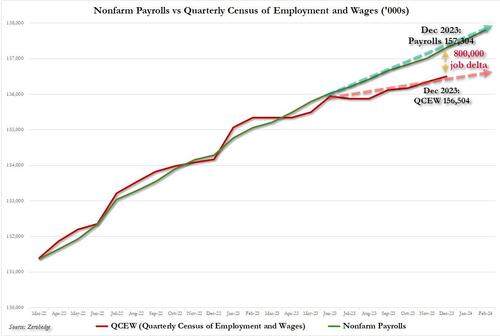

The Philadelphia Federal Reserve's startling revelation of an 800,000-job discrepancy in reported growth casts doubt on the robust employment narrative.
In a recent revelation that has sent shockwaves through economic circles, the Philadelphia Federal Reserve has disclosed significant discrepancies in job growth statistics, challenging the robust employment narrative presented by the Biden administration. The Philly Fed's quarterly census of employment and wages found a staggering variance when compared to numbers from the Bureau of Labor Statistics (BLS). Instead of the 1.1 million jobs touted by the administration, the actual increase was a mere 10,000 – a 110-fold miss indicating stagnant job growth rather than the proclaimed boom.
The implications are profound. It was previously reported that the economy experienced healthy job growth; however, according to the latest data from the Philly Fed, 23 states actually saw job losses during the same period. This new insight casts doubt on the seemingly stellar unemployment rate, suggesting that the low numbers may be due in part to individuals exiting the workforce altogether, rather than an increase in employment.
The BLS's overstatement of employment figures by approximately 800,000 jobs through December – potentially exceeding a million if the trend continued into the new year – hints at a reality where job growth is about half of what official numbers claim. This discrepancy comes at a time when the federal government is injecting a colossal $6 trillion into the economy, with $2 trillion of that sum being debt-financed, raising questions about the actual impact of such fiscal measures on employment.

The process of reporting major government numbers, which relies heavily on statistical adjustments like seasonal adjustment and company birth-death models, does not involve direct counting. This is because real-time data is often unavailable, and responses from companies and workers can be incomplete or inaccurate. Government statisticians are then tasked with interpreting these fragmented pieces of data, adjusting them to present a seemingly accurate economic picture.
However, concerns arise regarding the motivations and incentives of those making these adjustments. While one might assume accuracy is the primary objective of a government statistician, the reality is that job security in government roles rarely hinges on the quality of one's work. Instead, it can be influenced by the alignment with administrative narratives that ultimately benefit budget allocations for their departments.
As the economy faces potential downturns, there is a growing sentiment that the inaccuracies in government reporting will only worsen. Once considered a fringe belief, the notion of manipulated government statistics is gaining traction, with institutions like the Philly Fed corroborating these concerns, at least in the realm of job numbers.